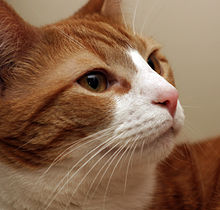
Back كلبة (شعر) Arabic Вібрысы Byelorussian Вибриси Bulgarian Vibrise BS Vibrissa Catalan Vibrisy Czech Knurhår Danish Vibrisse German Vibrisas Spanish موهای سبیل Persian
This article may be too technical for most readers to understand. (April 2021) |


Whiskers or vibrissae (/vəˈbrɪsi/; sg.: vibrissa; /vəˈbrɪsə/) are a type of stiff, functional hair used by most mammals to sense their environment.[1] These hairs are finely specialised for this purpose, whereas other types of hair are coarser as tactile sensors. Although whiskers are specifically those found around the face, vibrissae are known to grow in clusters at various places around the body. Most mammals have them, including all non-human primates[2] and especially nocturnal mammals.
Whiskers are sensitive tactile hairs that aid navigation, locomotion, exploration, hunting, social touch and perform other functions.[3]
This article is primarily about the specialised sensing hairs of mammals, but some birds, fish, insects, crustaceans and other arthropods are known to have similar structures also used to sense the environment.
- ^ Feldhamer, George A.; Drickamer, Lee C.; Vessey, Stephen H.; Merritt, Joseph H.; Krajewski, Carey (2007). Mammalogy: Adaptation, Diversity, Ecology (3 ed.). Baltimore: Johns Hopkins University Press. p. 99. ISBN 978-0-8018-8695-9. OCLC 124031907.
- ^ Van Horn, R.N. (1970). "Vibrissae Structure in the Rhesus Monkey". Folia Primatol. 13 (4): 241–285. doi:10.1159/000155325. PMID 5499675.
- ^ Grant, Robyn A.; Breakell, Vicki; Prescott, Tony J. (13 June 2018). "Whisker touch sensing guides locomotion in small, quadrupedal mammals". Proceedings of the Royal Society B: Biological Sciences. 285 (1880): 20180592. doi:10.1098/rspb.2018.0592. PMC 6015872. PMID 29899069.